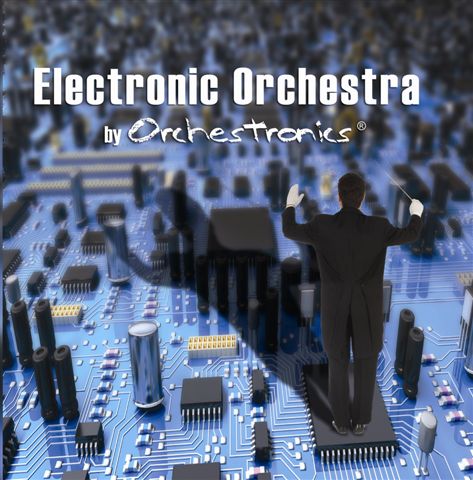Orchestronics (Or'-kes-TRON-iks) is the all-inclusive orchestra. Classic acoustic sounds mix with new instruments in a nearly limitless ensemble. The roots of our past (classical styles) and the seeds of our future (technological advances in music production) grow into many hybrid blossoms.
The Orchestronics Electronic Orchestra is a collection of synthesizers and recorded samples of acoustic instruments. The strings are real, the woodwinds are real, all the standard orchestral components are acoustic samples, electronically engineered to be played from a keyboard. Synthesizers add new instruments to the ensemble with electronically produced sounds.
The Tracks:
Duet for Any Two Keyboards
(3:55)
This
recording is piano vs. synthesizer. The synth, always the
chameleon, changes
sounds at will. Both parts make full use of the keyboard range, unlike the
usual left hand/right hand arrangement. So, much hand-crossing adds a
special challenge for one musician. Two players are recommended though, so
one hand is free to change patches on the synth. Although, one adept
keyboardist could pull it off.
Dreamcycles (7:50) for orchestra and electronics. The sleepy intro droops into a slightly dissonant chord, which signals the beginning of the dreams. If you've ever noticed someone twitching as they sleep, you'll understand what comes next. Just as sleep has its cycles, dreams stretch and compress, morph and change. A synthesizer adds a touch of surrealism that reminds us "it's only a dream." As an integrated player in the orchestra, the synth adds color and timbre, shining through on its own only occasionally. Various scenarios play out, until the cycle ends with that familiar dry-sounding mechanical alarm clock.
Watching the Clock (7:59) for orchestra and electronics. If you're familiar with the phrase "hurry up and wait," you'll understand the many moods of Watching the Clock. Though time remains constant, our perceptions of it change in speed. A brief calm intro is quickly contrasted by a hurried "ticking" bed, with a slowly moving theme superimposed over it. Interrupted by brief moments of building frustration, as if the hands of the clock are moving to slowly, the paced rhythms continue. A slow interlude interlude could be a sign of surrender to nature's time superiority, or it could simply be the lunch break in a busy work day when "it's okay" if time seems to pass more slowly. The relentless pace resumes and builds, until a final ritardando ends this busy day.
"Electronic" Symphony #1 in D-minor An all-electronic orchestra tackles this grand old form of classical music. This unlikely collection of sounds finds a common voice as an ensemble The new instruments introduce sounds, styles and techniques to the the classic symphony.
I. "Gathering"
(1st
Mov't) 7:13
A wily gathering of quirky characters
begin by stating a dark, almost menacing theme. As if calling a meeting to
order, the rules are loudly presented, and once ominous melody becomes the developing
topic of conversation.
II. "Reflection" (2nd Mov't) 7:52 Electronic instruments have a softer side, too. The sometimes emotionless technological emulations show their heart with ebbing and flowing melodies, and a brisk and sweeping development.
III. "Business at Hand" (3rd Mov't) 5:48 This is a flurry of activity on a mission. The diligent rhythm motivates the frenetic workers who just seem to love their melodic jobs.
IV. "Unity" (4th Mov't) 6:01 The main themes of the previous movements are restated with variation to show unity of purpose. Then, the same motif that appears in each of the other movements provides the basis for a short 3-part fugue, to show cohesion within the newly-formed group, ending with with the final theme in unison. Meeting adjourned.
The Arsenal:
-
Kurzweil K2000R w/orchestral ROM
Waldorf Blofeld
Korg Z1 Synthesizer
Roland XV-5050
Korg M3R w/cards
Ensoniq EPS
Polymoog
Supporting players:
-
Studiologic SL-880 Pro
Digitech DSP 256-XL
S-Com 4-channel compressor/gate
Tascam DP-01 PortaStudio
Kawai MX-8SR Stereo Mixer
Pro Tools
Sibelius Notation
PowerTracks Pro Sequencer
History of: "Electronic" Symphony #1 in d-minor Symphony #1 was an undertaking I had put off for many years. I wanted to be armed with a better understanding of sound design and symphony structure. After completing a multi-year cycle of almost traditional orchestral works (Dreamcycles, Watching the Clock, Incompatibility Issues), I was ready to jump back into the fully electronic world with both feet.
For my first symphony, I set out to create an electronic orchestra. Even though many factory presets and patches emulate acoustic instruments, I chose to avoid these tempting sounds, and tried to let the synths come into their own. As I started with factory synth sounds, and began to customize, I quickly realized that most of these presets were based on somewhat extreme attacks and effects. This was not helpful in finding patches that blend well together, as do orchestral instrument groups.
As I softened these attention-grabbing presets, they began to lose much of their character, especially as I worked on the 2nd movement, which called for sweeter, more fragile sounds. There were plenty of great acoustic emulations of pianos, woodwinds and horns, but I was hoping to shy away from them, or at least tweak them heavily, so they would not be mistaken for samples.
Since I was not composing for a known ensemble, I did not feel limited by size or configuration. Electronic keyboards sound best when playing only one or two notes at a time, unlike the piano. So, electronic instruments are more like individual orchestral parts than featured soloists. Since every instrument is a unique and custom creation, even a written score cannot duplicate my results when performed by others. So, off I went to create a one-time experience, that by design, is open to interpretation and variation.
While composing the symphony, I eventually realized that my aging equipment had its limits. After completing the first three movements, in June 2008, I added a Waldorf Blofeld for the fourth. I also decided to let some of the sounds remain quirky, and allow them to shine through.
An ensemble of quirky instruments can be a bit much, so I wanted to showcase them individually, and in small groups. Constantly introducing new sounds had become the cornerstone of the piece, at the risk of overshadowing the music itself.
The 4th movement is mostly a reprise with variations on the major themes, with an added fugue, based on the symphony's main theme.
Although each movement may seem long, by modern
short-attention-span standards, I felt the 1st symphony should be a
full-length thesis, instead of a collection of short, snappy song-length
movements that might be considered a half-effort. Perhaps Symphony #2
will be shorter.
-Joe Wiedemann
ALBUMS:
Electronic
Orchestra
Moving Parts
Next Stop
Keyboard
Orchestra
Colors of
Orchestronics
Aesthetic Piano
My Chill Space
Painted Variations
Element of Risk
Agitate
Electro-Acoustic
Orchestra
Bulls & Bears
ABOUT:
Composer
Bio & Credits
MUSIC:
Hear the Music
Concerto
VIDEOS:
YouTube
Music for Pictures
SCORES:
Sheet Music
PRESS:
Newsletter
Reviews
EXTRAS:
What's New?
Gallery
CONTACT:
Email
Us
Copyright 2025, Orchestronics





